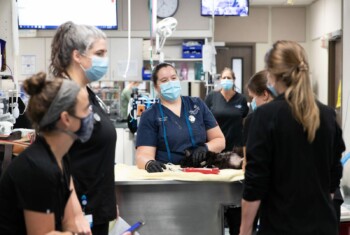Burnout and compassion fatigue are growing problems among veterinarians.
Veterinarians are up to 3.5 times more likely to die by suicide than the general population. This disproportionately high suicide rate is caused by a mix of factors that include compassion fatigue, “burnout syndrome,” and occupational stressors such as poor work-life balance, heavy student loan debt, coping with euthanasia, and cyberbullying.
While compassion fatigue and burnout are widely acknowledged within the human healthcare field, these concepts are new to veterinary medicine, explained Sonja Olson, DVM, former Senior Emergency Clinician at BluePearl Specialty and Emergency Pet Hospitals in the Tampa Bay area.
My fellow doctors and I were going through burnout and didn’t know it. Compassion fatigue and burnout were just not a part of our vocabulary,” said Dr. Olson, who transitioned to a support role in BluePearl’s Clinician Talent Acquisition & Development Team after 20 years of clinical ER medicine/surgery.
Recent studies have shown that anxiety and depression are common among veterinarians, as are related personality traits like perfectionism.
When I was practicing, we all were stoic and thought that we had to be perfect and fix everything. This notion of perfectionism, mixed with extremely long work hours—sometimes 14 to 15 hour shifts—has been the culture in veterinary medicine for a very long time,” Dr. Olson said.
The Cyberbully
Instant communication channels like Facebook and Twitter have created an “always switched on” culture that has added a new layer of issues for veterinarians.
Dr. Olson specifically attributes the rise in veterinary cyberbullying to the growing use of social media. “This new communication environment affords cyberbullies, who generally are upset pet owners, anonymity. People can now attack and accuse doctors from behind a screen,” she explained.
Although cyberbullying has not been directly linked to suicide among veterinarians, it can increase risk of suicide by intensifying feelings of isolation and hopelessness for people with preexisting emotional, psychological, or environmental stressors.
Access and Awareness
Increasing access to social work services and raising awareness of mental health are critical steps in the fight to reduce the high rate of veterinary suicide.
Around the country, many veterinary schools are now talking to students about mental health, with some even incorporating mental health education into the curriculum.
On the social work side, students can now become certified in veterinary social work through the University of Tennessee’s (UT) Postgraduate Veterinary Social Work Certificate Program. Recognizing the need for social workers within the industry, BluePearl has partnered with UT to help facilitate nationwide field placements that will prepare social work students for careers in specialty and emergency veterinary medicine.
When I was working in the field, there was nobody to talk to, and you didn’t share how you felt with others in your practice because you didn’t want anyone to look at you as if you were the weakest link. In reality, though, we all were going through the same thing, just in varying degrees,” Dr. Olson explained. “If we begin to change the conversation around mental health and promote a culture of open communication and understanding, we can start to decrease the things that cause us to suffer, and more importantly, ensure that no one is suffering alone.”
Building a Wellness Plan
It is fundamental that veterinarians and technicians create their own, unique wellness toolboxes to build resiliency. To do this, consider what coping strategies work, which do not, and explore new ways to support your healthiest you.
Wellness Plan Tips:
- Learn how to say “no.” Draw boundaries around your time off and stick to them.
- Learn to let go. Trust the technicians and doctors to continue the care of patients.
- Take time to restore yourself, emotionally and physically. Consider adding mindful moments and/or meditation to each day. Eat wisely and take at least 20-30 minutes/day to move/exercise.
- Improve sleep hygiene/habits. Keep a consistent sleep schedule and establish a relaxing bedtime routine. Also, be sure to turn off electronic devices at least 30 minutes before bedtime.
- Educate yourself on the signs of burnout and compassion fatigue, and stay self-aware.
- Seek out and sustain connections to your family and community.
- Maintain a respectful work environment.
If you or someone you know may be contemplating suicide, seek out a mental health professional or call the National Suicide Prevention Lifeline at 1-800-273-8255.


